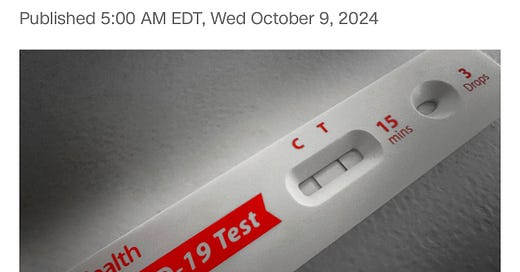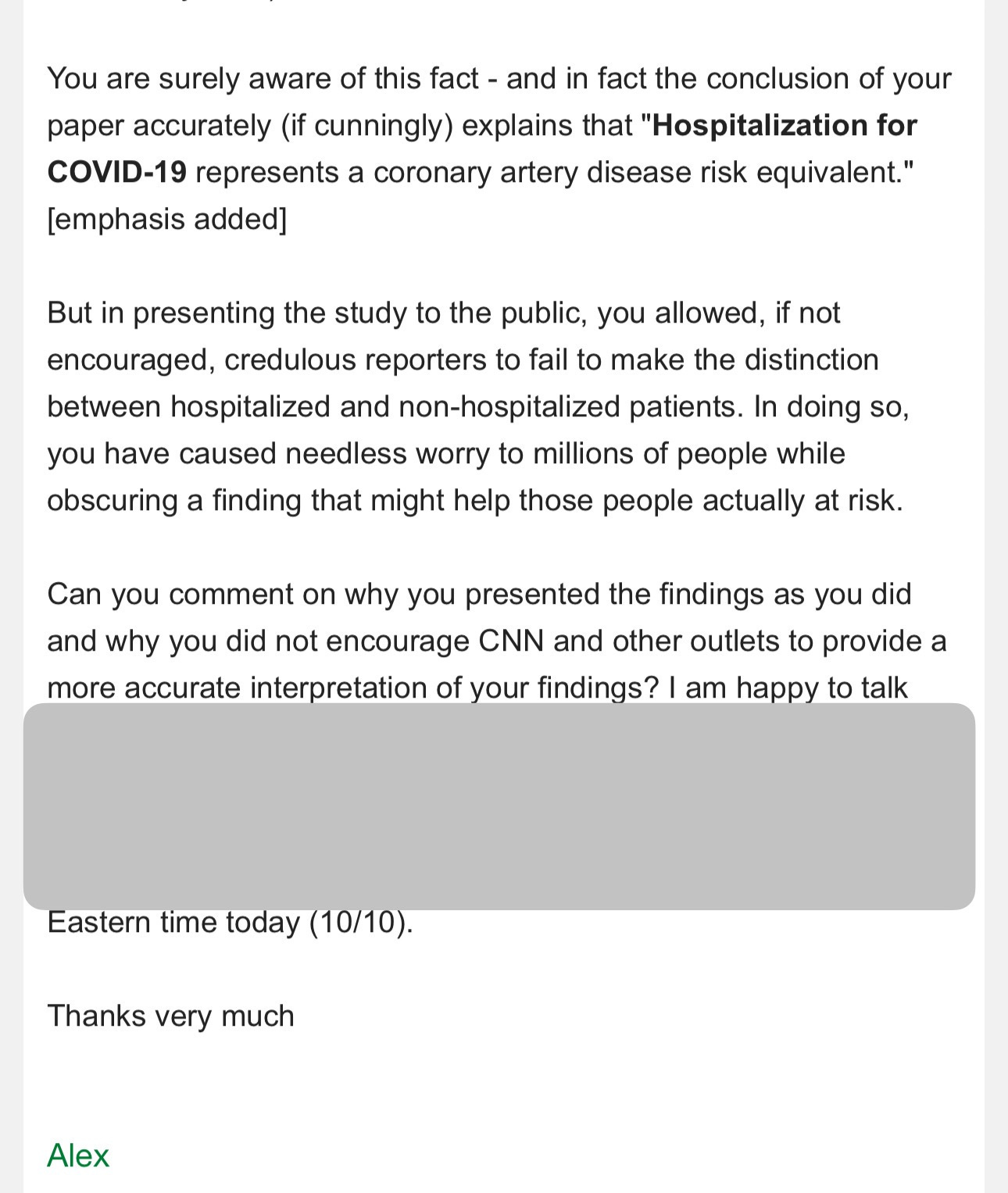URGENT: Authors of a big new paper on Covid's heart risks presented its results in a misleading way likely to scare people the paper itself shows are not in danger
The study, out on Wednesday, appears to have found NO extra long-term cardiovascular risks for most people infected with Covid. But the Cleveland Clinic, NIH, and the authors pretended the opposite.
On Wednesday, the Cleveland Clinic released frightening news:
“History of COVID-19 Doubles Long-term Risk of Heart Attack, Stroke and Death”
The renowned medical center was publicizing new research led by Dr. Stanley Hazen, one of its top physicians. He and other scientists examined the medical records of people infected with Covid in 2020 and found they had twice the risk of serious cardiovascular problems as uninfected people through 2024.
The National Institutes of Health, which funded the work, also put out a release warning Covid-19 “increased risk of heart attack [and] stroke up to three years later.” CNN and other media outlets also reported on the research with similar language.
In the Cleveland Clinic press release, Dr. Hazen did not sugarcoat the dangers. “The findings reported are not a small effect in a small subgroup,” he said. “[They] point to a finding of global healthcare importance that promises to translate into a rise in cardiovascular disease globally.”
Except they don’t. Hazen’s promise isn’t true.
—
(Keeping them honest, even when they think they’re too elite to be fact-checked. ESPECIALLY when they think they’re too elite to be fact-checked. Stand with me.)
—
The study’s real findings are very different than the frightening headlines.
For the vast majority of people who have had Covid, the research offered reassuring results. It showed essentially no increase in risk in heart attacks, strokes, or deaths for them.
Yet Hazen and his co-authors are not outright lying about what they found in their paper, which was published in the peer-reviewed journal Arteriosclerosis, Thrombosis, and Vascular Biology.
To run the study, they looked for Covid infections among British adults in 2020 a large database called UK Biobank. They came up with about 10,000 adults who had had Covid, and compared them to a group of about 220,000 adults who had not.
They found that over the next three years1, the 10,000 infected people were more likely than the uninfected control group to have heart attacks, strokes or die — an endpoint called MACE, or major adverse cardiovascular events.
As the paper reported, “the risk of MACE was elevated in COVID-19 cases at all levels of severity (HR, 2.09).” [emphasis added, keep that phrase in mind]
But. Hazen and the study’s other authors published and discussed the results in a way that hide a crucial fact.
The entire extra danger they found appears to have come only from the extreme risk suffered by about 2,000 people who were hospitalized with a Covid-19 infection. Those people were almost four times as likely to die or have heart attacks or strokes as the control group.
The other 8,062 infected people - those infected but not hospitalized - suffered heart attacks, strokes, and deaths at basically the same rate as the control group.2
—
Specifically, 350 of the non-hospitalized group had MACE events in three years, a rate of 4.3 percent. In contrast, 9,183 people in the control group of 217,730 suffered similar events, a rate of 4.2 percent.3
The authors did not disclose these facts anywhere in the paper. They are available only in the supplemental appendix. Even there they have to be reverse-engineered, as they are never provided openly.
In the paper itself, the authors briefly mentioned the doubled risk for the entire group of 10,000. They used the phrase “all levels of severity” to make it sound like the non-hospitalized group had double the risk, while the hospitalized group had four times.
This wording is canny: “all levels of severity” includes rather than excludes the hospitalized group, so authors are basically double-counting the hospitalized group’s risk to hide the lack of extra danger for everyone else.
The authors then spent the rest of the paper focusing on the hospitalized group, parsing its risk in many different ways.
But they never - never, not even in the supplemental data appendix - provided a risk ratio for the non-hospitalized patients.
This was scientific and medical malpractice. Roughly 98 percent of all adults, and 90-95 percent of adults over 60, who get Covid are healthy enough to recover without hospitalization. Their risk - or lack thereof — should have been clearly disclosed.
The authors appear to know just what they were doing. They began their conclusion: “Hospitalization for COVID-19 [emphasis added] represents a coronary artery disease risk equivalent…”
—
(If CNN says it, it must be true.)
—
Hiding the real source of the risk is doubly problematic.
It unnecessarily frightens people who had mild Covid cases. Meanwhile, it doesn’t encourage people who were hospitalized with Covid to realize that they may actually be at increased risk of heart attacks and strokes and should focus on their cardiovascular health.4
Why did Hazen and his co-authors present their findings in this way?
I asked. Yesterday, I emailed a detailed list of questions about the paper to Hazen, as well as Dr. Hooman Allayee, another senior author, and NIH and the Cleveland Clinic. I also offered them a detailed explanation of my methodology and invited them to dispute or correct it. This issue is too important for any mistakes.
—
(My email is too long to reproduce in full, but here’s the top…)
…and the bottom:
—
Only the Cleveland Clinic responded - with a single sentence repeating a line from the paper.
In fact, the paper must vastly overstate Covid’s long-term heart risks. Why? As many as one-third of Americans were infected with Covid in 2020 (and everyone else has been infected since).
If Covid had really doubled the long-term risk of heart attacks, strokes, and deaths, emergency rooms and funeral homes would be overwhelmed. The rise in cardiovascular disasters that Dr. Stanley Hazen promised would already be here.
—
(One more time - this work isn’t always easy, but it’s always necessary. I need your help.)
—
Instead, statistics from the American Heart Association and Centers for Disease Control show that heart disease deaths in the United States have been essentially unchanged since 2020. They actually fell in 2023 compared to 2022.
No doubt Hazen knows the real numbers very well. And no doubt he knows exactly how he shaded his findings. After all, he is the director of the Center for Cardiovascular Diagnostics & Prevention at the Cleveland Clinic, among the world’s leading centers for cardiovascular health.
But why let the facts get in the way of a good story? Especially when there’s research money at stake?
To be precise, 1000 days - or two years and nine months.
In the sample, one in five people who had a Covid infection were hospitalized - about 20 percent of all Covid cases. That figure is far higher than the true percentage of Covid cases that require hospitalization, which researchers have found to be about 2 percent for all adults.
The difference results from one “real” factor - the average infected person in the study was almost 65 and thus had a roughly 5 to 10 percent chance of being hospitalized in 2020 - and one statistical artifact. Covid tests were hard to get in 2020. Thus it is almost certain some people had Covid but were not tested and thus not counted in the infected group. Further, those cases were likely to be mild. In other words, the method of counting the researchers used inevitably made Covid look worse than it was, because it missed milder cases that didn’t lead to hospitalization and didn’t have long-term impact.
For technical reasons involving the fact that the two groups were not exactly matched (and potential dropouts in the larger group whose results were not known), the 4.2 percent and 4.3 percent figures are not exactly comparable. But they are close enough. They are also so close to each other and based on such large and relatively comparable groups as to all but exclude the possibility that the infected but non-hospitalized group was at significantly higher risk than the larger 217,000 person sample.
Again, for technical reasons, the study may ALSO have overstated the risks in the hospitalized group - they really should be compared to hospitalized people and not a general population sample - but let’s not get into that.






If the science community is trying to win back the 65% of us that has lost total belief of these 'experts', they're doing a bang up job
It is not clear whether there are other confounding factors not taken into consideration as well. For example, a person who had a Covid infection in 2020 could have gotten a Covid jab in 2021/2 and suffered some cardiac event thereafter. How would that impact the idea that it was the original 2020 infection that is associated with the 2022/3 cardiac event?